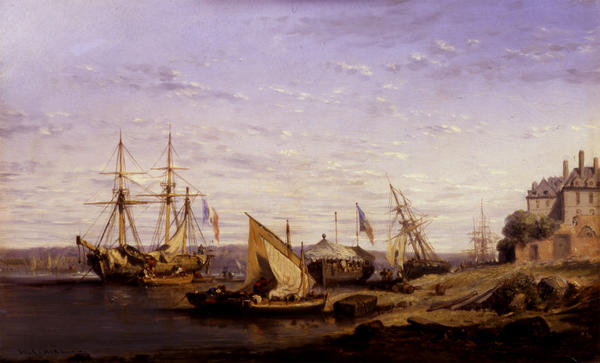One managed to find quite a few data about the author of the painting. He was born on the north-west of France in Quimper, the oldest of Bretagne cities, at the confluence of rivers Aude, Steir and Je, which the name of the city (Kemper in Bretagne language means ‘confluence of rivers’) is associated with. Probably, the family relocated there since Noel obtained artistic education in Brest. The name of his teacher is known: Sheriu. Jules Noel possessed the art of painting, watercolor; his lithography is well known.
In 1840 the artist settled down in Paris. Almost during forty years, from 1840 to 1879, his paintings participated in the exhibitions of Salon. The views of Bretagne, landscapes and seascapes were the most frequent objects in his paintings. Seemingly, the artist travelled. He died far from his native country, in Algeria. The creativity of Noel is exhibited in the museum of his native city as well as in the museum of Dieppe. The paintings of Jules Noel are presented at contemporary auctions.
The architecture of houses on the seashore, flat terrain of the opposite shore and cold identity point out to the fact that the picture was most probably painted in Bretagne, so dear to the artist. The watery waste opens up behind the mast of the ship. The artist followed the classical build-up of the landscape. At both sides the image is limited by a semblance of curtains. The space is expanding into the depth. The quality of painting suggests that the artist was a careful observer of nature.
The architecture of houses on the seashore, flat terrain of the opposite shore and cold identity point out to the fact that the picture was most probably painted in Bretagne, so dear to the artist. The watery waste opens up behind the mast of the ship. The artist followed the classical build-up of the landscape. At both sides the image is limited by a semblance of curtains. The space is expanding into the depth. The quality of painting suggests that the artist was a careful observer of nature.
We are not aware whether he worked on open air, however, the image of water, sky, seaside edge of the earth are sighted in nature and not imagined in a workshop. The composition is calm and steadfast, diagonal lines of ship masts harmoniously introduce a dynamic moment into the painting. Practically, everything in the painting is in the state of movement as it is intrinsic of the nature, especially, a seaside one, where deep mobility of the water element transforms the entire landscape into movement. The artist does not strive for superficial effects; however, he acts in accordance with his own skillfulness and inclination.
The merits of Noel’s paintings become uncovered in a leisurely contemplation of his creation. The landscape is not dated, however, it, in its quality, can be attributed to a mature period in the artist’s creativity. The painting kept with the Radishchev Museum evidences the professional craftsmanship of the artist. Not only its picturesque merits but also the degree of its preservation testifies about this. Over the time of its keeping in the museum the picture found itself on the table of restorer only once. The artist diligently complied with the rules of the technology. In 1960 the picture was cleared of stains and vanished.



